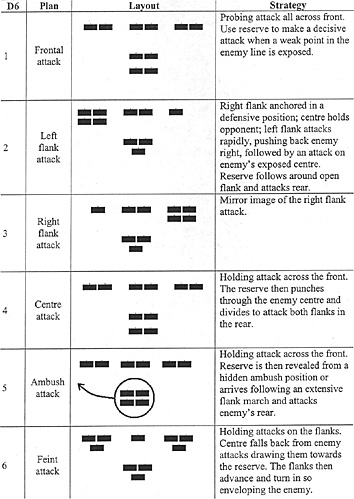The Plans

A six sided dice (d6) score gives a plan, a layout and a strategy for a programmed wargame opponent. The layout diagram is based on the concept of a block representing about 10% of the army. The diagrams split the armies into four groups: the left flank, centre, right flank and a reserve shown in the rear. The strategy outlines the way in which the programmed attack should be undertaken.
Releasing the Reserves
If the dice roll of a d6=6 then the reserves are released this move. +1 to the die throw if the front line or the enemy’s front line is breached.
Using the Rules
Here are two ways you can use these rules but perhaps you can think of other methods as well. For both these concepts I would suggest that the player has to have a reserve of at least 30% of his force that can only be released with a dice throw.
- 1. The player draws up his own battle plan and then generates the programmed opponents plan using the rules. The wargame table is prepared using a method to randomly generate the terrain. The terrain is either generated after you write your orders so that you do not have the advantage of planning to suit the terrain (perhaps it was foggy and you had lost those very poor maps). Alternatively you can plan once the terrain has been laid out but be aware you have given yourself a significant advantage. Perhaps remedy any advantage by reducing the number of troops from your own side.
2. Prepare the wargame table and then generate two battle plans using the rules. One will be for the programmed opponent and the other will be for the player’s army (maybe they are orders received from a superior officer!) The challenge is to do the best with what you’ve been given.
Notes and Ideas
Major factors affecting plans include enemy dispositions, the terrain and the timing and use of reserves.
Enemy dispositions can be assumed to be unknown with both sides making their plans independently. Perhaps there is little reliable intelligence to work with. We can also assume the positions are prepared during an overcast night and strong picket lines keeping the scouts away.
The terrain of the battlefield is not considered in these rules. That might result in problems such as a rapid attack being attempted through woodland or marshland or a small force making a holding action on an open plain. However these situations can be overcome by special rules:
- 1. A fast attack through woodland / marshland could be made possible by using local guides who know paths though these obstacles.
A holding action on an open plain may be possible by a small force if we permit it to be entrenched or in a fort.
A general rule of solo wargaming that I have always found helps to give an interesting and challenging game is:
“Always allow the programmed opponent the ‘benefit of the doubt’ or an extra help. However, the player’s army must always stick strictly to the rules and only err on the side of disadvantage to itself.”
The timing of the release of the reserves has been left to the chance of a dice throw. Many factors can delay the deployment of reserves so perhaps this is acceptable or maybe a new rule considering more factors as dice modifiers could be created.
The use of reserves is another important consideration. By the time the reserves are released there will be many calls for their assistance. The plans offer specific uses for the reserves but it may be essential to send some units elsewhere, to support holding actions at the point of breaking for example. Sometimes reserves are wasted where they are not really required because the local commander was nervous and called for them. Perhaps another dice throw can dictate how the reserves are actually used; please share your ideas in Lone Warrior if you have some thoughts on how this can be done.
Back to Table of Contents -- Lone Warrior # 146
Back to Lone Warrior List of Issues
Back to MagWeb Magazine List
© Copyright 2004 by Solo Wargamers Association.
This article appears in MagWeb.com (Magazine Web) on the Internet World Wide Web.
Other articles from military history and related magazines are available at http://www.magweb.com
